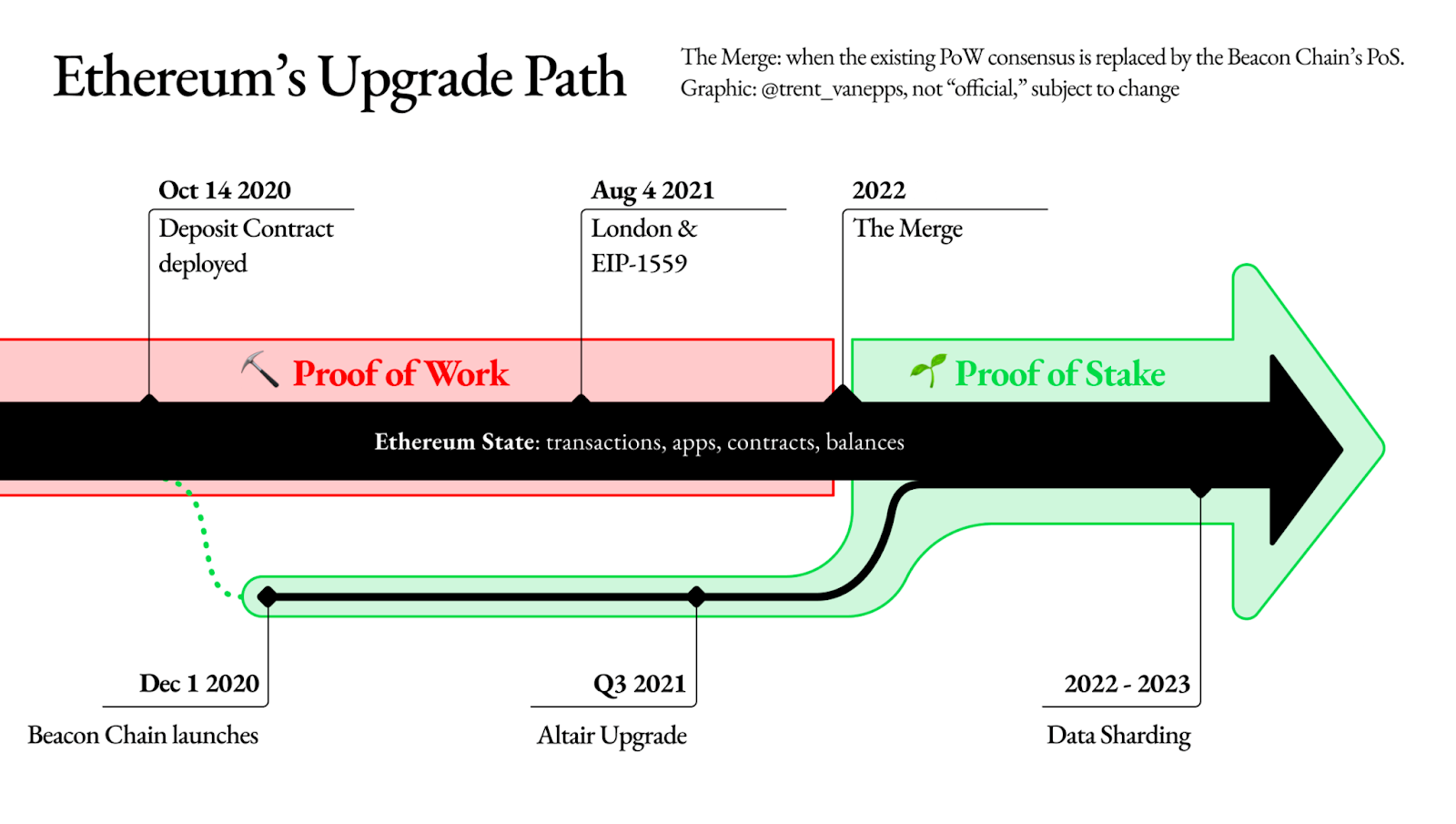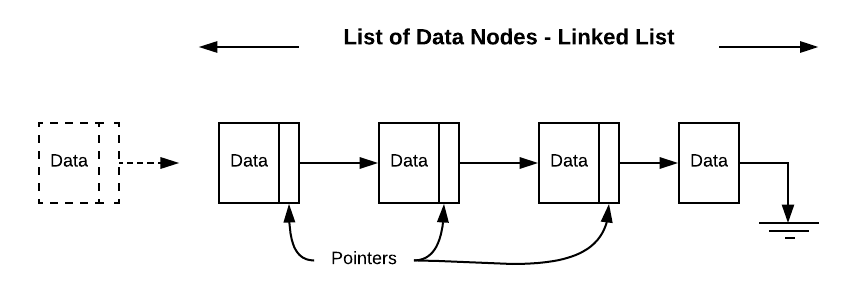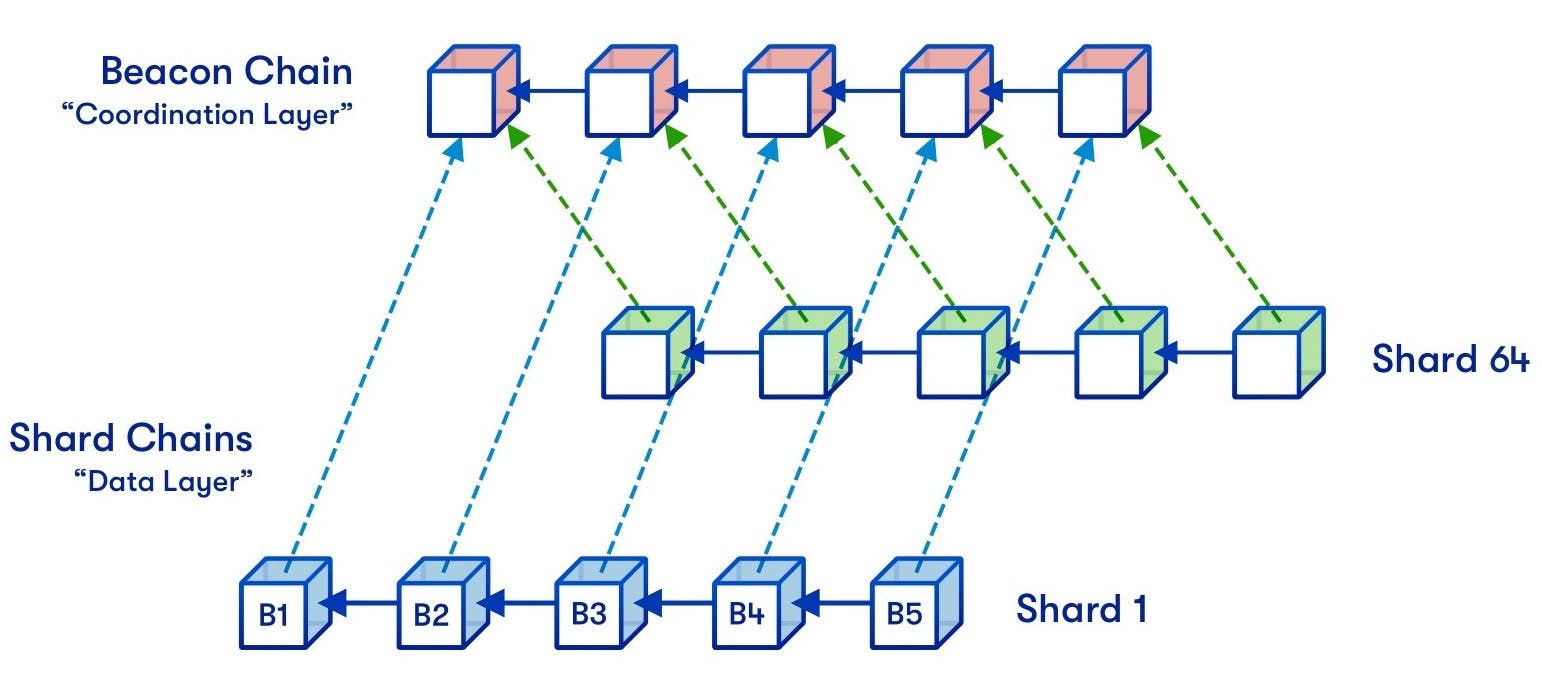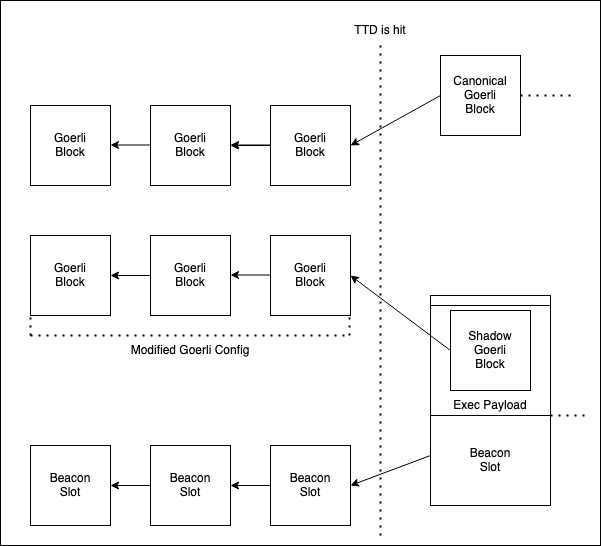
The Ethereum Merge
Written by Alchemy
On September 15, 2022, The Ethereum Merge was successfully implemented by the decentralized community. While proof of work is fully reliable and secure, ensuring thousands of nodes will reach a consensus, it comes at a cost. Proof of work requires a lot of computing power to solve complex problems, and because of this, also requires lots of energy.
Proof of stake does not require energy-intensive equipment and still improves efficiency, increases decentralization, and resists censorship. Proof of stake is now the new standard for the entire network.
What steps on the Ethereum roadmap are required for The Merge?

Steps required on the Ethereum roadmap to get to The Merge include the addition of the beacon chain, removing the proof of work consensus layer, and merging proof of stake into the Ethereum mainnet.
What is the Beacon Chain?
The Beacon Chain is a fully independent decentralized network running parallel to the Ethereum Mainnet that uses the proof of stake consensus mechanism instead of Ethereum’s current Proof of work consensus mechanism.
The purpose of the Beacon Chain is to support the transition from proof of work to proof of stake, and it is the first step needed to complete the merge.
The Beacon Chain transition started in November 2020 when a one-way bridge started moving the proof of work chain to the proof of stake chain and started accepting deposits. One month later, the Beacon Chain launched and secured millions of ETH across several validators. So far the Beacon Chain has not experienced any downtime or network interruptions.
What is the Merge?
The Merge is a planned Ethereum network upgrade that removes the proof of work consensus layer and merges the Beacon Chain’s proof of stake network into the current Ethereum mainnet. Ethereum’s consensus mechanism is a contribution to the network following Eth1. Eth1 was known as the execution layer. This will soon be deprecated as we migrate towards Eth2, now renamed The Merge.
Primarily The Merge will focus on the execution of upgrading the consensus mechanism and bringing it in line with its original mission: to migrate from proof of work to proof of stake, validate transactions on the blockchain, and add new blocks.

What happens to Ethereum’s consensus layer and data layer during The Merge?
During The Merge, the consensus layer was upgraded, and the data layer remained unchanged. Ethereum’s blockchain data is structured so that it consists of two fundamental elements: a pointer and a linked list.
A linked list is a list of chained blocks that contain data and use pointers that point toward the previous block. Since The Merge was not the launch of a new version of Ethereum but rather an upgrade, the data layer wasn’t affected in this process.
Once this transformation is complete, Ethereum will now be at a point of a more sustainable, eco-friendly ecosystem.
What happens after The Merge?
After The Merge, the Ethereum blockchain will prioritize adding new features planned through a separate upgrade, a post-merge cleanup, and sharding. Some of the planned features include things like allowing stakers to withdraw staked ETH.
The post-merge "cleanup" upgrade addresses these features, which is expected to happen very soon after The Merge is complete.

Finally, the process of sharding will be used to further scale Ethereum. Right now, Ethereum can only handle about 15 transactions a second. With sharding, Ethereum will have the capabilities to scale thousands of transactions by splitting the blockchain into “shards” (separate chains).
Sharding is a commonly used Web2 strategy for scaling databases. However, with Ethereum, this will lower the barrier of entry for validators to store and run data and is much more convenient than running the entire blockchain. Running an Ethereum node from your laptop or mobile device would soon be possible thanks to shard chains.
5 Common misconceptions of The Merge
1. Stakers get unburnt fees
Not all of Ether is burnt in a transaction fee. Unburnt fees, or tips on the execution layer, will be sent to stakers. This is due to proof of stake that will exist after the merge. In addition to new Ether minted as a block reward, you also get 30% of all transaction fees.
2. Once the merge happens, you will be able to withdraw ETH
You won’t be able to withdraw your ETH post-merge. There will be another update about 6 months later, at which point you’ll be able to withdraw. Keep in mind that the ETH you stake will be locked until the update to withdraw exists. The merge aims to keep simplicity, focusing on one step at a time.
3. The merge will reduce gas fees
This is not the case. Sharding will reduce gas fees, but this will be a focus post-merge. This later phase is expected in 2023. It should be known that Layer 2s will begin to take on a larger role post-merge as well.
4. Running a node post-merge requires ETH
This is another misconception. Ethereum never required ETH to run a node. You can be a staking validating node and add transactions to the blockchain, or you can be a listening node and send transactions to the mempool via your own node. It’s easy and accessible to run a node. No ETH is necessary in order to run a node.
5. A new ETH2 token will exist and be minted
This is not true, since the Ethereum network won’t have a new network, nor a new token. This is why the Ethereum Foundation is doing away with the “Eth1” and “Eth2” terminology.
What are some testing strategies currently used for The Merge?

Most recently, Ethereum developers ran a test called the Kiln merge tesnet, which allows the community to practice running nodes, deploying contracts, testing infrastructure, and more.
The Kiln testnet uses “shadow forking”, which inherits the state of existing testnets and allows us to stress test our sync assumptions as well as assumptions around how long it takes to build a block/timeouts. Kiln is expected to be the last merge testnet before existing public testnets are upgraded.
The main focus is that Ethereum encourages users to continue testing the merge in order to ensure it functions fully before the actual event of the merge.
What are the timelines for The Merge testnets and mainnets?
Most of the testnets and mainnets will be determined in the future. However, the next test is set for April 22. The purpose of these tests are to surface any potential issues and resolve them as soon as possible. This will make it more comfortable for developers to familiarize with Ethereum, post-merge.
With that being said, Ethereum developer Tim Beiko expects that The Merge could happen in July of 2022 as a “rough estimation”. According to his colleague, Ethereum developer Marius Van Der Wijden, it’s only a matter of time before The Merge becomes a historical event.
How to help Ethereum launch The Merge?
There are many ways you can help, from staking ETH, to running a client, to finding and reporting bugs, and even by joining the Ethereum development Discord channel.
Stake ETH
If you currently have Ethereum, you have the ability to stake it into the blockchain. This will make users become validators, enabling them to earn rewards while also securing the network.
Staking is more sustainable for the environment. There are several ways to stake with Ethereum, which includes solo staking, staking as a service, pooled staking, and through centralized exchanges.
Run a Client
If you’re interested in diving deeper into helping Ethereum, you can also run a client. This will mean you will be able to run software that runs the blockchain, checks transactions, and creates new blocks. This is also known as using “consensus layer clients”, in which Ethereum provides a distribution of clients.
Find and Report Bugs
Finally, for those that have more technical backgrounds, finding bugs within Ethereum can be one of the most helpful tasks you can do. Reporting bugs can enable you to earn up to $50k USD. Ethereum has a leaderboard that also shows the top bug hunters.
Join the Community
In addition, joining the Ethereum community through the Eth Research and Development Discord can also be helpful. They specifically have a Merge #testing channel for people to collaborate!

Related overviews
What is Blockchain Sharding and How Does it Relate to Ethereum?
Learn About Safe (Justified), Finalized, and Latest Commitment Levels
Learn How Ethereum Transactions are Propagated Across the Ethereum Network

Build blockchain magic
Alchemy combines the most powerful web3 developer products and tools with resources, community and legendary support.